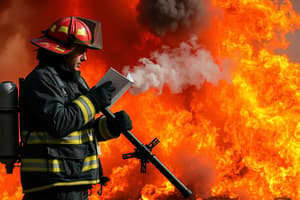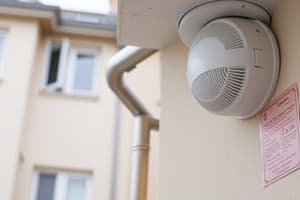Podcast
Questions and Answers
What are the four key attributes of smoke leaving a structure?
What are the four key attributes of smoke leaving a structure?
- Volume, velocity, density, and temperature
- Volume, velocity, density, and color (correct)
- Velocity, mass, flammability, and color
- Density, pressure, color, and toxicity
What are the two primary sources that contribute to smoke development at a building fire?
What are the two primary sources that contribute to smoke development at a building fire?
- Thermal degradation and complete combustion
- Chemical reactions and pyrolytic oxidation
- Incomplete combustion and pyrolytic decomposition (correct)
- Volatile materials and off-gassing
Which of the following best describes off-gassing in the context of smoke production?
Which of the following best describes off-gassing in the context of smoke production?
- The combustion of flammable liquids exclusively
- The release of particulates, aerosols, and gases from materials chemically degraded by heat (correct)
- The emission of non-toxic vapors from burning synthetic materials
- The process of burning materials producing gases only
Which statement accurately reflects the relationship between open flaming and combustion efficiency?
Which statement accurately reflects the relationship between open flaming and combustion efficiency?
What happens to materials in today's plastic-rich environment when exposed to exothermic energy?
What happens to materials in today's plastic-rich environment when exposed to exothermic energy?
What are particulates in the context of smoke composition?
What are particulates in the context of smoke composition?
Which of the following gases is considered volatile and commonly found in smoke?
Which of the following gases is considered volatile and commonly found in smoke?
What is the primary effect of off-gassed smoke on air within a room?
What is the primary effect of off-gassed smoke on air within a room?
What occurs in a ventilation-limited condition in a fire?
What occurs in a ventilation-limited condition in a fire?
Which factor is NOT influencing the behavior of a compartmentalized fire?
Which factor is NOT influencing the behavior of a compartmentalized fire?
What is indicated by the velocity of smoke in a fire scenario?
What is indicated by the velocity of smoke in a fire scenario?
During which phase of a ventilation-controlled fire does explosive growth occur?
During which phase of a ventilation-controlled fire does explosive growth occur?
Which phenomenon is characterized by the ignition of smoke without sustained burning?
Which phenomenon is characterized by the ignition of smoke without sustained burning?
What condition leads to backdraft in a fire environment?
What condition leads to backdraft in a fire environment?
What characterizes ghosting in fire behavior?
What characterizes ghosting in fire behavior?
What does the density of smoke indicate?
What does the density of smoke indicate?
In the ignition phase of a fire, what brings together to start combustion?
In the ignition phase of a fire, what brings together to start combustion?
What is the result of a successful flashover in a room?
What is the result of a successful flashover in a room?
How does the presence of smoke control systems influence fire behavior?
How does the presence of smoke control systems influence fire behavior?
What is a common consequence of a backdraft event?
What is a common consequence of a backdraft event?
Which smoke characteristic is primarily used to indicate the stage of combustion?
Which smoke characteristic is primarily used to indicate the stage of combustion?
What effect does breathing in thick, black smoke have on a victim?
What effect does breathing in thick, black smoke have on a victim?
What should be done to PPE surfaces after exposure to contaminants from smoke?
What should be done to PPE surfaces after exposure to contaminants from smoke?
What does black smoke indicate in a fire situation?
What does black smoke indicate in a fire situation?
What is the term 'black fire' used to describe?
What is the term 'black fire' used to describe?
How does humidity in the air affect smoke behavior?
How does humidity in the air affect smoke behavior?
What is an expected change in smoke attributes when effective firefighting efforts are in progress?
What is an expected change in smoke attributes when effective firefighting efforts are in progress?
What can the observation of swirling or 'breathing' smoke indicate?
What can the observation of swirling or 'breathing' smoke indicate?
What does the term 'neutral plane' refer to in firefighting?
What does the term 'neutral plane' refer to in firefighting?
What role does container size play in analyzing smoke observations?
What role does container size play in analyzing smoke observations?
Which statement indicates a failure of positive pressure attack (PPA) tactics?
Which statement indicates a failure of positive pressure attack (PPA) tactics?
What should an Incident Safety Officer (ISO) do upon detecting tan/brown smoke from lightweight wood buildings?
What should an Incident Safety Officer (ISO) do upon detecting tan/brown smoke from lightweight wood buildings?
During the reading of smoke, what does the rate of change of smoke attributes signify?
During the reading of smoke, what does the rate of change of smoke attributes signify?
What does the presence of brown smoke typically indicate?
What does the presence of brown smoke typically indicate?
What phase of fire behavior is characterized by rapid ignition of smoke due to reintroducing air when a door is opened?
What phase of fire behavior is characterized by rapid ignition of smoke due to reintroducing air when a door is opened?
Which of the following best describes a backdraft?
Which of the following best describes a backdraft?
What does a laminar velocity of smoke indicate within a compartment?
What does a laminar velocity of smoke indicate within a compartment?
Which statement about the four-phase fire behavior model is true?
Which statement about the four-phase fire behavior model is true?
What is the significance of the color of smoke during a fire event?
What is the significance of the color of smoke during a fire event?
What can indicate a potential flashover situation within a compartment?
What can indicate a potential flashover situation within a compartment?
Which factor does not affect the flow paths of smoke in a building fire?
Which factor does not affect the flow paths of smoke in a building fire?
What is the best initial action a firefighter should take upon entry into a structure with zero-visibility smoke?
What is the best initial action a firefighter should take upon entry into a structure with zero-visibility smoke?
What term describes the phenomenon where smoke escapes from a compartment at an open door's edge due to air pressure differences?
What term describes the phenomenon where smoke escapes from a compartment at an open door's edge due to air pressure differences?
Which of the following conditions is indicative of 'black fire'?
Which of the following conditions is indicative of 'black fire'?
In terms of smoke characteristics, what attribute is most revealing in assessing heat conditions?
In terms of smoke characteristics, what attribute is most revealing in assessing heat conditions?
What should firefighters do if they encounter black fire conditions during an interior operation?
What should firefighters do if they encounter black fire conditions during an interior operation?
What is typically the initial temperature threshold for smoke ignition?
What is typically the initial temperature threshold for smoke ignition?
Which fire phenomenon involves a momentary ignition of smoke away from the actual fire?
Which fire phenomenon involves a momentary ignition of smoke away from the actual fire?
Flashcards are hidden until you start studying
Study Notes
Introduction
- Reading smoke enhances the ability to predict fire behavior and manage fire attacks.
- It aids incident commanders with incident action plans and monitoring attack effectiveness.
Smoke Dynamics
- Smoke has four critical attributes: volume, velocity, density, and color (VVDC).
- Comprised of particulates from incomplete combustion and pyrolytic decomposition, smoke includes toxic gases and aerosols.
- Sources of smoke:
- Incomplete combustion of burning materials.
- Pyrolytic decomposition of non-burning materials releasing particulates, aerosols, and gases.
Predicting Fire Behavior
- Open flaming reduces harmful combustion products, promoting complete burning of fuels.
- Low-mass materials contribute to fast smoke development and can create ventilation-limited conditions.
- Ignition of smoke requires:
- Proper air mix.
- Sudden spark or flame; once ignition temperature is reached, only air mixture is needed.
Compartmentalized Fire Growth Phases
- Traditional four-phase fire behavior model outdated; six-phase ventilation-controlled model is more relevant today.
- Phases of a ventilation-controlled fire:
- Ignition phase
- Initial growth phase
- Ventilation-limited phase
- Explosive growth phase
- Fully developed phase
- Decay phase
Hostile Fire Events
- Phenomena like flashover, flame-over, smoke explosion, and backdraft pose threats to firefighters.
- Warning signs for hostile events:
- Ghosting signals potential for flashover.
- Flame-over involves overhead smoke layer ignition.
- Smoke explosion is a momentary ignition from a spark hitting trapped smoke.
- Flashover results in simultaneous ignition of surfaces in a room.
- Backdraft occurs from sudden air reintroduction in oxygen-deprived spaces.
The Art of Reading Smoke
- Reading smoke requires identifying characteristics, analyzing influencing factors, and predicting consequences.
- Volume indicates fire's visibility; low volume suggests well-ventilated fires, while high volume indicates a severe fire.
- Velocity represents pressure; faster smoke indicates closer proximity to the fire.
- Density of smoke relates to its thickness and potential to cause harm, where thick smoke is dangerous to life and visibility.
- Color of smoke provides an indication of heat and burning materials, where black indicates high heat, while white suggests cooler temperatures.
Factors Influencing Smoke Reading
- Weather conditions, temperature, humidity, and wind impact smoke characteristics.
- The size of compartments and container size influences smoke behavior and must be considered.
- Firefighting efforts affect smoke attributes; positive changes indicate effective suppression.
Three-Step Process for Reading Smoke
- Step 1: Observe and compare smoke attributes (VVDC) from various openings.
- Step 2: Analyze contributing factors affecting smoke characteristics.
- Step 3: Monitor the rate of change in smoke attributes to gauge fire conditions.
Conclusion
- Modern building designs and contents contribute to severe and rapid fire incidents.
- Effective reading of smoke leads to better intervention strategies and fire service preparedness.
- Continuous practice and analysis of smoke behavior improve firefighting outcomes, with significant emphasis on safety against toxic smoke exposure.
Studying That Suits You
Use AI to generate personalized quizzes and flashcards to suit your learning preferences.




